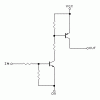What you have there is an emitter follower. The emitter will "follow" the base voltage, with a voltage drop of about 0.7V. So when the base is at +3V, the emitter will be at about +2.3V, which may not be enough to light the LED.
The normal way to drive an LED is using a common emitter saturated switch. The general design is:

The bottom rail, marked "0V rail", is the common "0V" ("zero volt") reference rail, also sometimes called GND, from the Arduino. The negative side of the 12V battery also connects to this rail.
The control signal from the Arduino enters at the left. When it is high (i.e. at some positive voltage, typically 3.0V, 3.3V, or 5.0V), current flows through RB into the base-emitter junction of Q1, and this turns it ON, i.e. makes it conduct current through its collector-emitter path.
Current then flows from the positive terminal of the battery, through the LED, through the resistor called RLED, through the transistor and back to the battery. This current illuminates the LED.
The LED current (which determines the LED brightness) is set by RLED. You calculate it using Ohm's Law (I = V / R), rearranged:
R = V / I
where
R is the desired resistance for RLED, in ohms (Ω);
V is the voltage across RLED, in volts - this is roughly equal to the supply voltage minus the LED's forward voltage;
I is the desired LED current, in amps.
Say you want to run the LED at 20 mA, and it has a typical forward voltage of 2V at 20 mA. (The forward voltage should be specified on the LED's data sheet; it's typically about 2V for red and green LEDs, a bit higher for yellow, and higher again for blue and white.)
V = (12V - 2V) = 10V
I = 0.02 amps (20 mA is 0.02 amps)
so:
R = V / I
= 10 / 0.02
= 500Ω.
You would use a close preferred value such as 470Ω, 510Ω, or 560Ω.
RBE is optional and seldom needed. It can be helpful if the driving signal doesn't go all the way down to 0V when it's low, or if you want the transistor to turn off extra quickly.
The circuit as shown is fine for driving LEDs. You can replace the LED and its series resistor with other types of low-current loads (the transistors listed can carry up to around 100 mA) but if the load is inductive - a relay coil, for example - you need to reverse-connect a diode across it, to absorb the high-voltage spike that an inductive load will generate when the transistor turns OFF.
You can just use 10 kΩ for RB in most cases. If you want to calculate an ideal value, or learn more about the circuit, Steve (a different one) has written a resource giving more details about common emitter saturated switches at
https://www.electronicspoint.com/resources/using-a-bipolar-transistor-to-turn-a-load-on-and-off.30/


